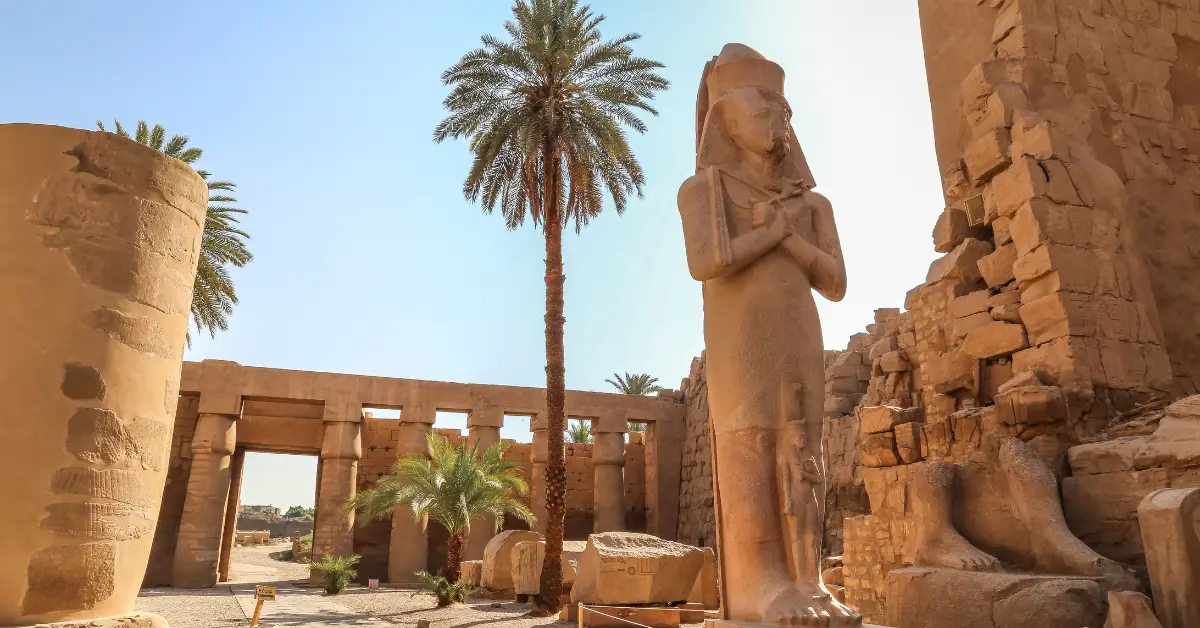Introduction
The Temple of Karnak, located in the ancient city of Thebes (modern-day Luxor), is an awe-inspiring testament to the grandeur and ingenuity of ancient Egyptian civilization. This vast temple complex, dedicated to the Theban triad of gods – Amun, Mut, and Khonsu – showcases intricate architectural designs and monumental structures that have captivated visitors for centuries. In this article, we will embark on a journey through the Temple of Karnak, exploring its rich history, architectural marvels, and the enduring fascination it holds for historians, archaeologists, and travelers alike.
A Brief History of the Temple of Karnak
The Temple of Karnak was built over a period of nearly 2,000 years, with successive pharaohs contributing their own architectural innovations and artistic embellishments to the complex. Construction began during the Middle Kingdom (circa 2040-1782 BCE) and continued through the New Kingdom (circa 1550-1070 BCE) and the Late Period (circa 664-332 BCE). The temple complex was dedicated to the worship of the Theban triad of gods, with the primary deity being Amun, the god of creation and fertility.
Architectural Marvels of the Temple of Karnak
The Temple of Karnak is an architectural wonder, boasting a vast array of monumental structures, intricate carvings, and imposing statues. Some of the most iconic features of the temple complex include:
- The Great Hypostyle Hall: Spanning an area of 54,000 square feet, the Great Hypostyle Hall is a breathtaking forest of massive stone columns, with 134 pillars standing up to 70 feet high. This architectural marvel once supported a roof, creating a grand entrance to the temple complex.
- The Obelisks of Karnak: The temple complex is home to several towering obelisks, some of which stand over 90 feet tall. These colossal stone monuments, intricately carved with hieroglyphs and religious scenes, were erected to honor the gods and celebrate the achievements of the pharaohs.
- The Sacred Lake: Situated within the temple complex is the Sacred Lake, a large, rectangular basin that once played a vital role in the daily rituals of the temple priests. The lake is surrounded by a colonnade and features a small island with a shrine dedicated to Osiris, the god of the afterlife.
- The Avenue of Sphinxes: The Temple of Karnak is connected to the nearby Temple of Luxor by the Avenue of Sphinxes, a nearly 2-mile-long pathway lined with hundreds of sphinx statues. These mythical creatures, featuring the body of a lion and the head of a human or ram, served as guardians of the sacred temple precinct.
The Enduring Fascination with the Temple of Karnak
The Temple of Karnak continues to captivate the imagination of historians, archaeologists, and travelers from around the world. Its architectural magnificence, rich history, and spiritual significance make it an essential destination for those seeking to explore the mysteries of ancient Egypt. Key factors that contribute to the enduring fascination with the Temple of Karnak include:
- Historical Significance: As one of the largest and most important religious complexes in ancient Egypt, the Temple of Karnak offers a unique glimpse into the religious practices, artistic achievements, and architectural innovations of this remarkable civilization.
- Architectural Grandeur: The sheer scale and intricacy of the Temple of Karnak’s structures, from its massive columns and towering obelisks to its elaborate carvings and statues, showcase the ingenuity and skill of ancient Egyptian builders and artisans.
- Cultural and Spiritual Legacy: The Temple of Karnak remains an enduring symbol of Egypt’s rich cultural and spiritual heritage, reflecting the civilization’s reverence for its gods and the divine nature of its pharaohs.
Conclusion
The Temple of Karnak stands as a testament to the grandeur and ingenuity of ancient Egypt, inviting visitors to journey through its monumental structures and unravel the mysteries of this captivating civilization. As we explore the architectural marvels, rich history, and enduring fascination of the Temple of Karnak, we gain a deeper appreciation for the human spirit of innovation, creativity, and reverence for the divine that has shaped our understanding of the ancient world. Whether you are a historian, archaeologist, or simply a curious traveler, the Temple of Karnak offers a unique and unforgettable adventure into the heart of ancient Egypt’s architectural and spiritual legacy.


